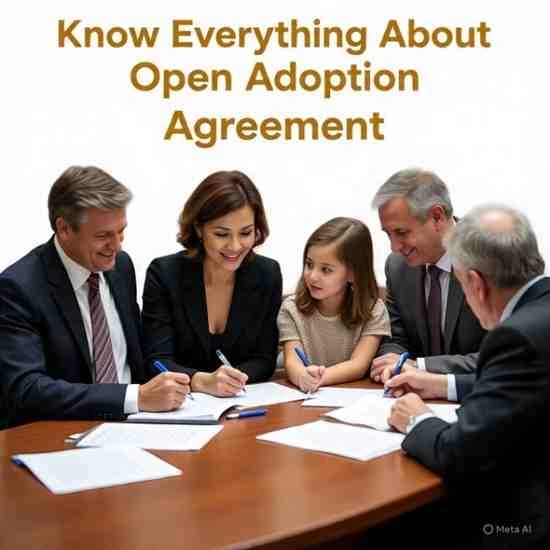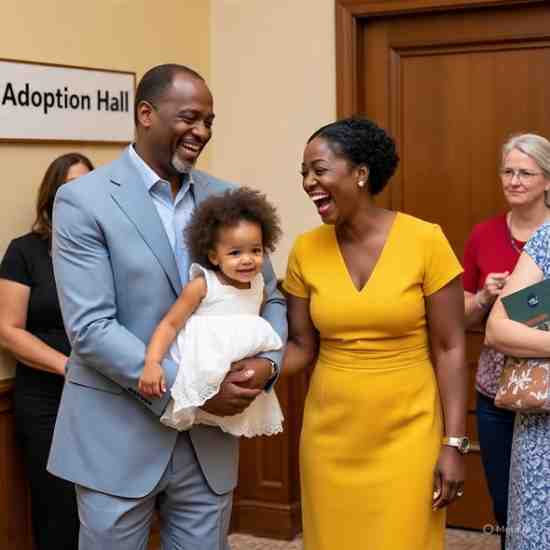Open Adoption Agreement: 12 Exclusive Things To Note Now

Did you know that about 95% of all U.S. home infant adoptions today involve some degree of openness between adoptive and birth families? This radical change from the closed adoption system of yesteryears is a testament to increasing awareness of the positive power of transparency for everyone involved in adoption.
An open adoption agreement is a formal agreement between adoptive and birth parents that defines the parameters of a continuation of the relationship and contact once the adoption has become final.
While in closed adoptions all parties involved will not know each other’s identities, an open adoption agreement defines explicit parameters for communication, visitation, and exchange of information that will occur over a lifetime.
To grasp the ins and outs of an open adoption agreement is important for adoptive parents who wish to uphold their obligations, for birth parents who desire to maintain significant relationships, and for the adopted children who gain from having a fully informed history.
An open adoption agreement has the potential for significantly affecting family relationships for years to come and should thus be entered into thoughtfully and in consultation with a professional.
What is an Open Adoption Agreement?
An open adoption contract is a legal document that specifies the interaction between adoptive and biological parents and the adoptee after the finalization of an adoption.
This contract often specifies how often the parties should communicate, schedules for visitation, protocols for the exchange of information, and boundary requirements that should be upheld by all parties involved.
The main differences between open and closed adoption are that there is open communication and a level of openness between the birth families and the adoptive families, while in closed adoptions, there is sealed identifying information and no communication from adoptive or biological families.
In an Open adoption, the birth family and the adoptive family still retain some level of communication, which includes everything from occasional letters and photos to more frequent visitations and phone calls.
For example, Johnson’s family adopted their daughter Emma under an open agreement with her birth mom, Sarah. The two families agreed to have monthly photo updates during the first year, quarterly video calls, and yearly face-to-face visits.
This level of specificity avoided guesswork and worry for the families. Sarah was certain about how well her girl was doing, and the Johnson’s enjoyed having clear parameters to adhere to.
Once Emma was five years old and inquiring about her birth mom, the established relationship made open discussions natural and truthful as opposed to secretive or hurtful.
The agreement also discussed day-to-day matters like courtesy gifts, Facebook protocols, and just how much they would tell Emma about her heritage, and it established a blueprint for navigating their non-conventional family composition’s unique circumstances.
Why Open Adoption Agreements Matter:
Open adoption agreements serve several basic functions that are beneficial for everyone in the adoption world. Emotionally, open adoption agreements provide stability and pre-knowledge for birth parents grappling with loss and grief while providing adoptive parents with assurances about their parentage.
Children are also less confused about their sense of identity and access to medical and cultural heritage history, and legally, it open adoption agreement helps to protect the rights and privileges of both the adoptive and birth parents.
Although each jurisdiction enforces it differently, it minimizes confusion and provides a more comfortable way for conflict resolution. The agreement also acts as a guide for the parties, especially when there are questions regarding boundaries, expectations, or shifting realities.
From a relational standpoint, open adoption agreements foster healthy communication patterns and establish trust among the families that will be bonded for a lifetime.
They offer structure for handling complex emotions and changing dynamics as children grow and form relationships of their own with members of their adoptive family.
Most significantly, agreements facilitate the child’s identity growth and mental health. Studies repeatedly confirm that adopted children who have access to birth family knowledge and relationships enjoy upgraded self-esteem, identity development, and total adaptation.
The agreement assures that this access is gained in a manner that facilitates, rather than hinders, the child’s main attachment figure or adoptive parent.
Things to Keep in Mind Exclusively for an Open Adoption Contract:

1. Clear Understanding of Contacting Frequency Between Families:
One of the most crucial components of any open adoption agreement is a delineation of clear expectations for communication frequency. Vague wording like “regular contact” or “periodic updates” leads to confusion and resentment when one family anticipates weekly calls and the other receives monthly visitations.
Successful arrangements specify exact frequencies: “Birth mom will receive photo updates by email every 15th of the month for the first two years, and quarterly thereafter.” This definiteness prevents guesswork and either family from feeling deluged or forgotten.
Plan carefully considering everyone’s ability. New parents can have difficulty managing weekly updates in the early months, and birth parents may require more frequent updates at the beginning to work through their loss.
The Miller family learned this lesson when their best-intentioned daily text updates became overwhelming for birth father Marcus, and he asked them to move to weekly calls.
Note that frequency needs may change later. Write in intervals for reviews—perhaps once a year for the next three years—to decide if the current interval satisfies everyone’s needs.
Some families have that contact build up at holidays or drop off during very busy periods of their lives, and that’s fine as long as there’s effective communication.
2. We Determine the Kind of Contact: Call, Visit, or Letter:
The communication mode has a profound impact on the emotional intensity and practical dynamics of maintaining an open adoption relationship.
Each type—in-person visitation, telephonic or video conference phone calls, handwritten letters, e-mail, or cell phone texts—necessitates different benefits and challenges that require consideration.
In-person sessions offer the strongest connection, yet need the most effort and preparation. They’re most essential in sustaining relationships with wider birth family members, yet are difficult when members of a family live at a considerable distance.
The family of Rodriguez managed around this by taking turns at video sessions and yearly visits, and by birth grandparents interacting through video when physical sessions couldn’t be achieved.
Digital communication offers flexibility and real-time contact. Video calling offers face-to-face communication without physical movement, and e-mail offers time for reflective reactions.
Technology also creates pressure for an individual’s prompt reaction or misinterpretations due to a lack of nonverbal communication.
Letter writing provides a more formal, long-lasting account of communication that children can retain as mementos.
They give time for thought and careful choice of words but are not necessarily more personal than other means. A variety of means is common for most families: a once-a-month e-mail by photo, a once-a-quarter video call, and a once-a-year letter that the child can retain.
3. Handling Boundaries to Protect the Child’s Stability:
To protect the emotional welfare of the adoptee, there needs to be boundaries that everyone knows and will respect. Those boundaries need to consider discipline, decision control, and what happens when the child becomes mixed up over family roles.
Clarity regarding parental authority avoids awkward moments. For instance: “The adoptive parents reserve final decision-making responsibility for medical treatment, education, and punishment. The birth parents confirm that they expect adoptive parents to make decisions and direct inquiries regarding a rule or punishment to adoptive parents.”
Boundaries around sensitive topics protect children from unnecessary conversations. Birth parents might agree not to discuss adult topics like their reasons for choosing adoption until the child reaches a certain age, while adoptive parents might commit to not speaking negatively about birth parents even during challenging moments.
The Chen family set limits when their son started requesting during visitation time that his birth mom enforce bedtime routines. Their new compromise was that the birth mother would enforce household rules and defer the youth to his parents for any decisions, all while upholding clear authority relationships and maintaining the unique bond.
4. Cultural and Heritage Issues in the Agreement
This is more essential in transracial adoption or when the adoptive and natural families are of diverse cultures. Understandings should also encompass how the child would learn and affiliate with their own cultural origin while living in a cultural setting.
They might detail: “Birth family will share cultural heritage, cooking, and holiday observances once a year. Adoptive family will observe [specific cultural holidays] and teach child simple [culture/ethnicity-specific]-language phrases.” This keeps cultural connections real and not an abstraction.
Discuss religion sensitively. While adoptive parents should generally decide on religious upbringing, provision might be included for the child to be taught about the faith traditions of the family of origin appropriate for their age.
The Patel family dealt with this by committing to their adopted daughter taking part in both the Hindu festivities at her family of origin and Christian services at her family of adoption, and knowing both.
Record significant cultural artifacts, foods, music, or traditions that the adoptive family would like retained. Make concrete arrangements for how these would be shared—maybe by yearly cultural celebration visits or monthly parcels of traditional foods and objects that maintain ties to the heritage of the child.
5. Adaptability When Situations Vary Over Time
Circumstances in life always change, and inflexible agreements become sources of contention instead of direction. Inclusion of flexibility in open adoption agreements avoids slight modifications from disrupting precious relationships while allowing necessary structure and planning.
Specify language regarding common transitions as follows: “If either family relocates over a distance of more than 100 miles, visitations shall be modified to once every six months while video call usage shall be enhanced.” This foresees probable eventualities and offers resolutions in a pre-emptive manner.
Address significant events of life such as remarriage, new children, loss of employment, or serious medical condition.
The Thompsons’ agreement also had a provision regarding what would occur should the birth mother go into substance abuse treatment, maintaining ongoing contact while taking precautions for everyone’s safety and well-being.
Establish formal review procedures with clear deadlines. Successful families often plan yearly “agreement check-ins” in which they mutually evaluate what goes well and what needs a change.
These discussions help avoid letting small problems fester and balloon into gigantic fights and yet let relationships develop naturally while preserving essential safeguards for the kid.
Note that flexibility always goes both ways—birth families will need to phase off contact at hard times, and adoptive families will need to accommodate communication at significant transitions like a move or new employment.
6. State or Country Variation in Legal Enforceability
Understanding the legal status of open adoption agreements in your own place is preferable for developing realistic expectations about enforceability. While open adoption agreements possess moral and ethical authority everywhere, legal enforceability has tremendous variability among states and countries.
While other states view open adoption agreements as enforceable legal agreements, other states view open adoption agreements as unenforceable “moral contracts.” In enforceable states, a court would grant specific performance or damages for breach.
In any event, a court would very seldom compel unwilling parties into relationships, and many times concentrate upon other remedies.
The legal climate continues to evolve as other states come to realize the importance of post-adoption communication for the well-being of children. Familiarize yourself with laws in the home country and other states that parties might relocate to.
This lesson was learned by the case of the Williams family when they moved from a state in which their contract was legally enforceable to one in which it was not, and were forced to renegotiate under new legal protections.
Even when not legally enforceable, well-crafted agreements provide valuable guidance for mediation services and adoption agencies. They demonstrate good faith efforts at honoring one’s word and are influential in subsequent controversies even without legal enforceability by the courts.
Get legal advice from lawyers knowledgeable in adoption law in your country and learn what protections are available and how best to phrase agreements for maximum coverage for your system.
7. Role of Mediators or Agents in Making Agreements
Experienced mediators and adoption agencies are essential to drafting well-considered, thorough open adoption agreements. They bring knowledge from a score or a hundred like cases and the wisdom of problems that families may not consider.
Trusted mediators guide families through emotional conversations objectively, allowing all voices to be represented while keeping the focus on the best interests of the child. They broker hard conversations regarding boundaries, expectations, and concerns that families may avoid broaching face-to-face.
Most adoption agencies also offer a template and direction based on model agreements by other families. Do not use one-size-fits-all methods—they are a family unto themselves. The template for the Martinez family was too inflexible for their wish for visitation and telephone calls each week, while the Browns required more direction than the template included.
Professional engagement isn’t final once the contract is signed. Ongoing mediation is available from some agencies when problems develop, allowing for neutral ground for resolving disputes before relationships are hurt. This support is priceless when agreements need to be modified or unexpected problems need to be worked out.
Choose professionals with some experience of open adoption and not of generic family law or mediation. Open adoption relationships require a clear understanding of the theory of attachments, adoptive children’s psychology, and the distinctive needs of the triads.
Updating and Re-reviewing Agreements as Life Changes
Regularly scheduled agreement reviews keep open adoptions running smoothly for all parties as circumstances change over time. Fixed agreements become points of frustration rather than useful guidance when no longer indicative of the current circumstances.
Hold scheduled formal reviews at significant points: once a year for the first three years, every three years afterwards, or at points of significant life change. Scheduled reviews render the process of adjusting normal and avoid inducing a feeling of culpability in families for seeking change.
Develop better ways to constantly review and evaluate every aspect of the agreement, and don’t forget to monitor levels of satisfaction at the moment, any difficulties, and the needs and desires of a maturing child, etc. Write down what’s going well to retain successful factors while tackling areas for improvement.
The Petersons’ five-year review revealed that their original twice-a-year visits proved unsustainable once adoptive dad Tom’s career transplanted the family cross-country. Rather than opting out of the agreement, the family negotiated more frequent video calling and summer visits per year, maintaining their relationship while rolling out new logistics.
Make provisions for emergency reviews should circumstances change radically. Job loss, illness, family expansions, or relationship status alterations might necessitate agreement alterations on an immediate basis in order not to disrupt significant relationships.
Common Pitfalls to Steer Clear Of in an Open Adoption Agreement:
One of the most common and problematic errors that families commit is not insisting firmly enough upon committing their agreements in writing and falling instead into a pattern of oral agreements that always amount to misinterpretations.
When families promise “to stay in touch regularly” and don’t specify precisely what “regularly” means, there always ensues disappointment and argument.
Another significant mistake is that verbal assurances are equal in weight to written agreements. Even though trust and good faith are integral components of open adoption relationships, human memories are frail, and conditions alter one’s opinions over time.
What appeared at the time of an emotional placement discussion as a bright-line agreement might be recalled quite differently six months later.
Most families also fall into the error of going it alone without appropriate legal advice, either to avoid expense or because they fully trust the other side. Even the best-intended families, though, are well served by expert experience of potential pitfalls and typical safeguarding wording that avoids later difficulties.
The most damaging mistake is creating far too rigid arrangements that fail to account for the fact that change is a natural aspect of living.
Families that insist on no flexibility in contact arrangements, no matter the work rota, relocation, additions of new children, or ill health, frequently have relationships disintegrating due to unrealistic expectations.
The Stevens family learned this lesson the hard way when their monthly visit requirements remained steadfast, even after the birth mother, Jennifer, went into substance abuse treatment. Instead of flexibility for visit support for Jennifer while keeping him connected, their inflexibility caused more stress that ended up tearing their relationship apart and confusing the son about why the visits ceased abruptly.
Actionable Tips for Creating a Healthy Open Adoption Agreement
The key to any effective open adoption agreement is collaboration with seasoned professionals who know the distinctive dynamics and potential pitfalls that this type of relationship involves.
Adoption lawyers, certified social workers, and trained mediators also have useful experience from hundreds of comparable cases and know what problems other families may not.
Invest in counseling for emotional preparation before finalizing agreements. Both adoptive and biological parents gain from working through their hopes, motivations, and fears with experienced professionals capable of bringing into focus for them potential challenges and learning effective coping techniques for navigating complex emotional reactions.
Make a child-centered focus for every decision of agreement and discussion. If there is a focus by families on what best benefits the child instead of adult preference or convenience, more balanced and durable arrangements ensue.
Ask yourselves: “How will this be best for our child as this situation develops and the child grows into adult relationships?”
Include regularly scheduled review times that normalize the process of adjusting and preclude tiny problems from blossoming into huge fights.
Successful families often place yearly “relationship check-ups” on their schedules during which time they discuss what’s going well and what needs adjusting just as couples might go for marriage counseling for maintenance and not for crisis intervention.
Finally, communicate honestly and openly in every communication. Open adoption relationships need greater degrees of communication and vulnerability that most are not used to, yet adoptive families that use honest sharing of authentic content rather than pleasant pleasantries at a superficial level develop healthier, deeper relationships that are healthy for everyone.
Conclusion:
The twelve individual guidelines laid out in this guide—from establishing clear contact schedules to providing flexibility in reaction to the unexpected changes of life—amount to a template for building open adoption agreements that accommodate everyone’s needs while safeguarding the adopted child’s well-being and healthy growth.
While effective open adoption agreements are more than pieces of signed paper, effective open adoption agreements involve emotional preparation, specialist consultation, and a long-term commitment to open communication among all parties.
The emphasis isn’t toward ideally preserved agreements that require no modification at all, but toward building a ground for healthy, changing relationships that are flexible and durable and that can accommodate shifting conditions while preserving significant relationships.
Above all else, maintain at the center of every choice the best for your child. Children derive much from knowing their entire histories and from knowing their relationships at birth when those relationships are healthy and supportive, but from stability, clear family roles, and protection from adult conflict or from unduly heavy responsibility.
Before executing any open adoption agreement, seek the guidance of experienced adoption attorneys, seasoned social workers, and skilled counselors knowledgeable about the unique dynamic involved in open relationships.
By doing so, steer clear of potential pitfalls and construct a plan that leads to a healthy family for years to come. Investing in the advice of professionals in contract drafting pays off in healthier relationships and less tension as a family grows and evolves together.




